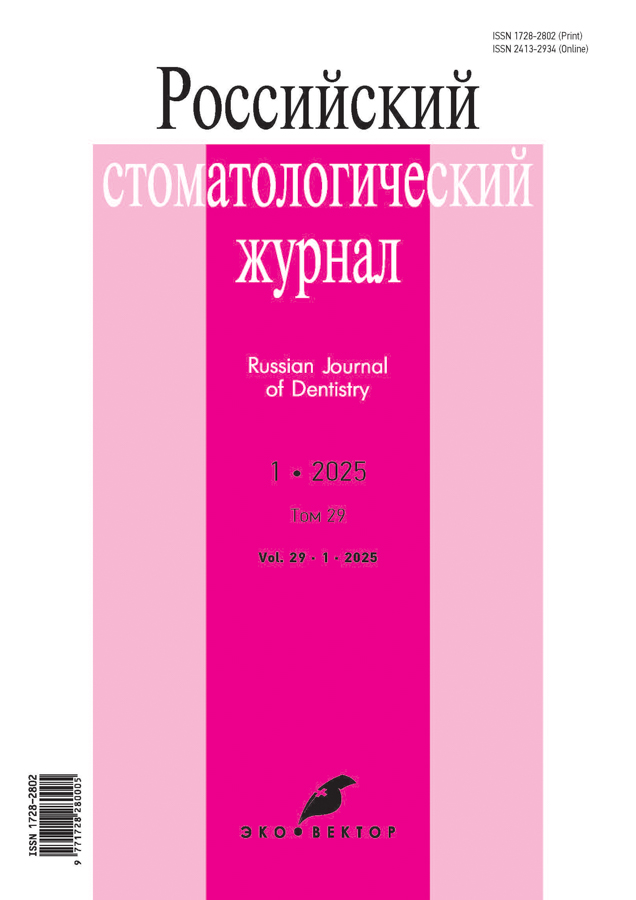The impact of hyoid bone position on the airway volume in patients with sagittal jaw relationship anomalies
- Authors: Ivanova O.P.1, Tsurova A.R.1, Biryukova L.I.1, Zatsarinskaya D.D.1, Ivanova A.I.1, Yanitsky V.V.1
-
Affiliations:
- Volgograd State Medical University
- Issue: Vol 29, No 1 (2025)
- Pages: 5-12
- Section: Experimental and Theoretical Investigations
- Submitted: 11.11.2024
- Accepted: 25.11.2024
- Published: 01.03.2025
- URL: https://rjdentistry.com/1728-2802/article/view/641778
- DOI: https://doi.org/10.17816/dent641778
- ID: 641778
Cite item
Abstract
BACKGROUND: The relationship between malocclusion and respiratory function is a pressing issue in modern orthodontics, as the position of the hyoid bone directly influences airway volume in patients with sagittal jaw relationship anomalies. Over the past decade, various authors have developed cephalometric analysis methods for assessing hyoid bone position using both lateral cephalometric radiographs and head and neck computed tomography. However, none of these methods have conclusively established an association between a distal jaw relationship and an increase in airway volume, or a mesial relationship and airway constriction. Thus, this issue remains unresolved.
AIM: To determine the impact of hyoid bone position on the airway volume in patients with sagittal jaw relationship anomalies.
MATERIALS AND METHODS: Two comparison groups were formed: the first included 74 patients with a tendency toward distal occlusion, and the second comprised 52 patients with a tendency toward mesial jaw relationship. The hyoid bone position was assessed on lateral cephalometric radiographs of patients with sagittal dentoalveolar anomalies by analyzing the GoMeH angle, formed by the tangent to the body of the mandible and the most superior and anterior point on the hyoid bone. Airway volume was analyzed using the Invivo 5 software (Anatomage, USA), based on the D.C. Hatcher color scale. Statistical analysis was performed using Statistica 13.0. Mean values were compared using Student’s t-test, and statistical significance was evaluated using a two-sample t-test and p-value.
RESULTS: A correlation was established between hyoid bone position and airway volume in patients with sagittal jaw relationship anomalies. In patients with mesial occlusion, the GoMeH angle decreased, but the airway lumen did not narrow. In patients with a distal jaw relationship, the GoMeH angle increased, but the airway volume either increased or decreased.
CONCLUSION: The position of the hyoid bone is directly linked to sagittal jaw relationship anomalies and affects airway volume. The obtained data can be applied in prosthodontic practice and orthodontic treatment planning, as well as for monitoring the treatment quality of sagittal malocclusions.
Keywords
Full Text
About the authors
Olga P. Ivanova
Volgograd State Medical University
Email: olgaa-75@mail.ru
ORCID iD: 0000-0002-1459-7747
SPIN-code: 3695-4637
MD, Dr. Sci. (Medicine), Professor
Russian Federation, VolgogradAmina R. Tsurova
Volgograd State Medical University
Author for correspondence.
Email: amina-tsurova@mail.ru
ORCID iD: 0009-0006-8725-2690
SPIN-code: 3626-0146
Russian Federation, Volgograd
Lidia I. Biryukova
Volgograd State Medical University
Email: lirabunny2015@gmail.com
ORCID iD: 0009-0004-2436-2468
SPIN-code: 7082-4940
Russian Federation, Volgograd
Daria D. Zatsarinskaya
Volgograd State Medical University
Email: Dari0906@yandex.ru
ORCID iD: 0009-0002-7803-5804
Russian Federation, Volgograd
Alina I. Ivanova
Volgograd State Medical University
Email: allina000@mail.ru
ORCID iD: 0009-0003-2275-6714
SPIN-code: 5338-7623
Russian Federation, Volgograd
Vladislav V. Yanitsky
Volgograd State Medical University
Email: Yanitsky2002@yandex.ru
ORCID iD: 0009-0008-2910-6446
SPIN-code: 1786-0402
Russian Federation, Volgograd
References
- Marchuk V, Polma L, Marchuk T. Assessment of upper airway and surrounding soft tissues in patients with different types of sagittal malocclusion using cone-beam computer tomography. Actual Problems in Dentistry. 2023;19(2):91–96. doi: 10.18481/2077-7566-2023-19-2-91-96 EDN: ODNXSY
- Marchuk VV. Evaluation of air flow parameters in the upper respiratory tract in individuals with dentoalveolar anomalies [dissertation]. Moscow; 2024. (In Russ.) EDN: ADLNCN
- Ishchenko TA, Bulycheva EA. Radiological analysis of craniomandibular and craniocervical postural balance based on the protocol of Professor M. Rocabado. Bulleten medicinskoj nauki. 2020;4(20):5–9. (In Russ.) EDN: OPUMIJ
- Dolbanenko VS, Strezhneva VO, Leontieva TS, Dechkina VP. Interrelation of postural disorders and orthodontic pathology: literature review. In: Education and science in modern realities. Collection of materials of the IX International Scientific and Practical Conference. Arhangel’sk: FGBOU VO “Severnyj gosudarstvennyj medicinskij universitet”; 2019. P. 35–38. (In Russ.) EDN: QJPPZO
- Indriksone I, Jakobsone G. The influence of craniofacial morphology on the upper airway dimensions. Angle Orthod. 2015;85(5):874 – 880. doi: 10.2319/061014-418.1
- Bulycheva EA, Mamedov AA, Dybov AM, et al. Protocol of cone beam computed tomography analysis for patients with craniomandibular dysfunction. Stomatology. 2020;99(6):94–100. doi: 10.17116/stomat20209906194 EDN: LRIIUV
- Hatcher DC. Cone beam computed tomography: craniofacial and airway analysis. Dent Clin North Am. 2012;56(2):343 – 357. doi: 10.10167i.cden.2012.02.002
- Marchuk VV, Polma LV. Three-dimensional cephalometric analysis of upper airways in planning orthodontic treatment. In: Collection of scientific papers of the 43rd Final Scientific Conference of OMU MMSU named after A.I. Evdokimov. 2021. P. 61 – 62.
- Bedoya A, Landa Nieto Z, Zuluaga LL, Rocabado M. Morphometry of the cranial base and the cranial-cervical-mandibular system in young patients with type II, division 1 malocclusion, using tomographic cone beam. Cranio. 2014;32(3):199–207. doi: 10.1179/0886963413z.00000000019
- D’Attilio M, Filippi M, Femminella B, et al. Malocclusion on vertebral alignment in rats: a controlled pilot study. Cranio. 2021;23(2):119–129. doi: 10.1179/crn.2005.017
- Koval YuN, Novikova ZhA, Tarasenko II. Oral breathing type and its influence on morphofunctional changes in the dentofacial region in children with pathology of the pharyngeal tonsil. Colloquium. 2021;10(97):11 – 15.
- Mamedov AA, Kharke VV, Morozova NS, et al. Diagnostic methods selection in patients with temporomandibular joint dysfunction. The Dental Institute. 2019;(2):74–77. (In Russ.) EDN: HTVSSH
- Fadeev RA, Parshin VV, Prozorova NV. Syndrome forced position of the lower jaw — nosological unit of temporomandibular joint diseases. The Dental Institute. 2020; (3):74 – 75. (In Russ.) EDN: STPKEA
Supplementary files














